DTP Guest Blog — Healthy Start Brooklyn

Healthy Start Brooklyn (HSB) recently added Dancing Thru Pregnancy to its services with terrific results. Find out more about HSB at http://fphny.org/programs/giving-brooklyn-families-a-healthy-start. This blog describes how DTP became a part of the program.
DTP: When did you first work or study with DTP?
HSB: We first discovered DTP in 2011 while researching evidence-based exercise programs for pregnant women. DTP was exactly what we were looking for! So in January of 2012, Healthy Start Brooklyn trained three former clients and one staff member to teach free DTP classes to low-income pregnant women in Central Brooklyn. It took some time for us to get the program up and running, but we have been offering classes since March of this year and they have been continuing successfully ever since.
DTP: Describe the focus or mission of your work.
HSB: Healthy Start Brooklyn is a federally funded program that seeks to improve the health and wellness of women, infants and families in Central Brooklyn. Rates of infant death, premature birth and illness in the neighborhoods of Bedford-Stuyvesant, Brownsville, Bushwick, East New York, and Flatbush are far higher than elsewhere in New York City and the U.S. as a whole. HSB provides support services, education and training to reduce these inequalities and improve the lives of Central Brooklyn residents. Our DTP classes, as with our childbirth education and doula programs, are aimed at trying to offer our clients free services that are available to more affluent women to help offset some these inequalities that can have a negative impact on birth outcomes.
DTP: What do you most enjoy about your work?
HSB: We enjoy seeing our clients coming back to class every week. Some of them have very little support systems in their lives, and it is extremely rewarding to see them participate in class each week and stay after class to talk to each other and share stories. It is our hope that the class not only positively affects their physical health, but also their mental health as well, serving as a place where they can de-stress and socialize with other women in similar situations. We also really enjoy receiving pictures of the babies that our class had some part in helping enter the world healthy!
DTP: What is the most important or interesting thing you have learned from working with moms, moms-to-be, or other women clients?
HSB: Pregnant women can move! In the beginning, we were nervous about making our class routines too high intensity for some of the women who were further along in their pregnancies. We were surprised to find that they could all keep up and were even requesting the higher intensity routines.
To learn more and see more photos, go to the DTP Blog:
http://dancingthrupregnancy.wordpress.com/

 Cathy Moore CNM, is the founder of In the Belly of the Goddess in the Boston area. She earned her pre/postnatal fitness certification from Dancing thru Pregnancy® in 2006. She used much of what she learned to develop a series of classes in belly dance for pregnancy and birth. We asked her to describe her program for this article.
Cathy Moore CNM, is the founder of In the Belly of the Goddess in the Boston area. She earned her pre/postnatal fitness certification from Dancing thru Pregnancy® in 2006. She used much of what she learned to develop a series of classes in belly dance for pregnancy and birth. We asked her to describe her program for this article.

